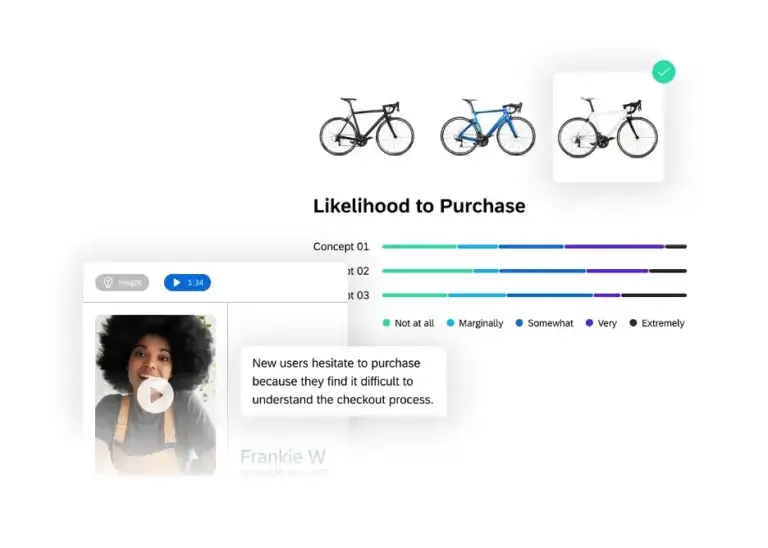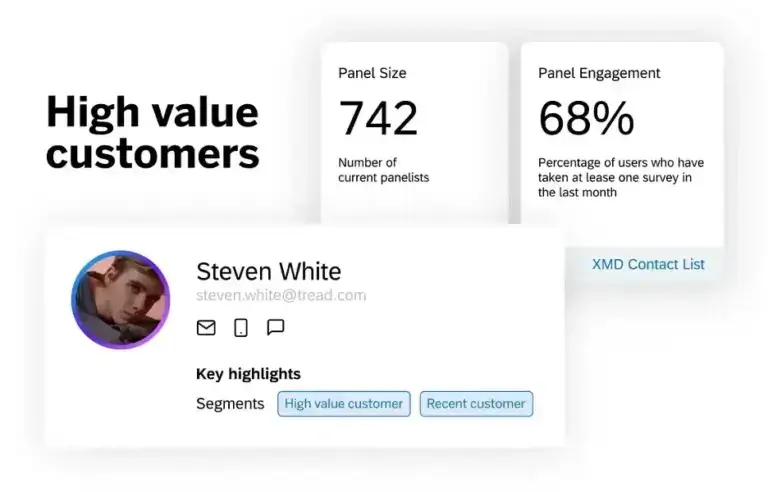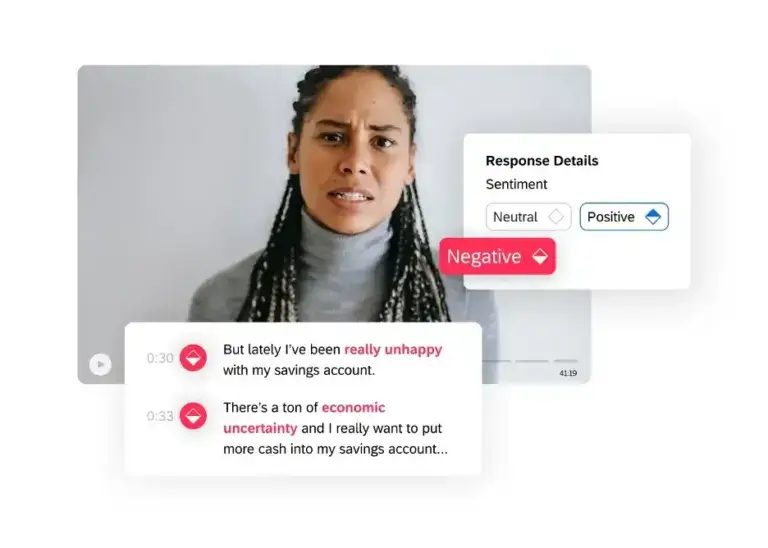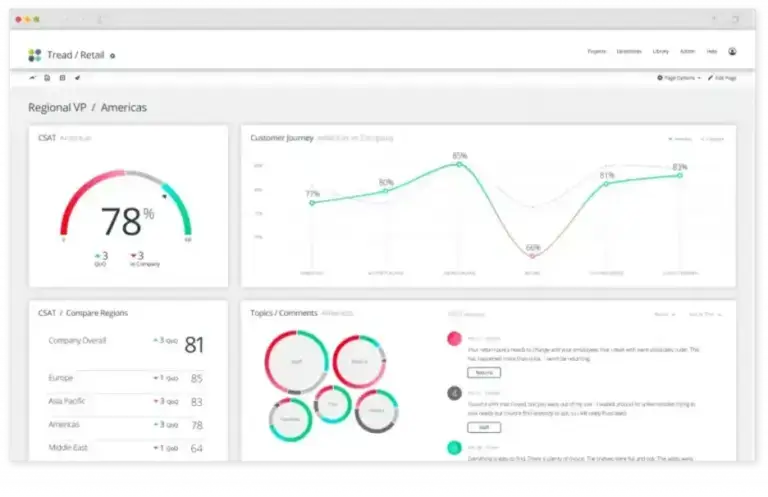Written by: Rosemin Anderson
Fact Checked by: Arwen Behrends
What is a user persona?
A user persona is a fictional but realistic character based on research and actual data that exemplifies a user for your business. A user persona is an in-depth profile of this typical person, with information about their goals, needs, background, attitudes and pain points.
This allows businesses to capture all the information they need to design products and create content that will be effective, as well as creating a more human-like way of representing research. With the right data, building user personas can be a highly effective way of representing your potential user’s needs and interests whenever you’re considering experiences, creating products, developing marketing and more.

But what information should you include in a user persona, and how do you bring it all together to start using your personas effectively? Read on to find out more.
What does a user persona consist of?
There are generally two types of approach to create personas: formulating a prototype or an archetype, or developing a full persona.
User archetypes will often be based on a limited amount of data or research, and are likely to be more one-dimensional, focusing on one specific goal or need fulfillment. They’ll contain higher-level descriptions, but not go into much detail on each specific user type.
A full persona is based on more in-depth research and data, and is likely to include the following:
- Identifying characteristics: This could be a name or nickname, or a “quote” that helps to identify this persona as distinct
- Demographics: This can include their age, marital status, number of children etc.
- Relevant user environment: What type of user environment might be assigned to this persona – are they a computer user or a mobile user?
- Psychographics: This is specific data around the potential values, desires, goals, interests and lifestyle factors of this user, i.e.:
- Behaviors: What actions do they typically take or behavior do they display?
- Attitudes: What are their attitudes towards religion, politics, social classes, the environment etc.?
- Interests: What are their interests and hobbies?
- Motivations: What drives them to take action?
- Pain points: What issues cause them friction or put them off?
- End goals: What is their end goal for any transaction or interaction with your brand?
- Scenario: What specific setting will they encounter your business in?
More than one persona is likely needed to represent all of the users you’d like to target. Ideally you’ll create a persona for the most important user groups you have, with your ideal customer or user in mind for each one.
Watch demo: Bring the voice of the user into every experience
User persona vs buyer persona
Though sometimes user personas and buyer personas can represent the same people, a user persona depicts the person who will be utilizing the end product or service. A buyer persona may also use the items they purchase, but they may be buying them for someone else or on behalf of an organization.
For example, a buyer persona could be a mother looking for children’s clothes, and a user persona could be her child. Both will have varying needs, desires and behaviors, which require a different approach.
When to use a user persona
A user persona can be helpful throughout all of a business’ processes, but here are two common times a user persona is created and used:
During strategic sessions
When a business needs to make informed decisions on new or current offerings, creating a user persona can help to establish a deeper understanding of your customers’ needs and pain points. Figuring out who your target audience is, the issues they face and identifying the highest opportunity for solutions means you’re more likely to design products and services that resonate.
When training your teams
Aligning your team members correctly is important. By employing user personas, your teams are more easily able to see the human side of your research. Personas become easier to remember because they’re more than just data – they’re a “person” they can empathize with. Creating a user persona means that all your teams, no matter their function, are referring to the same set of information when making decisions that could impact the end user’s experience.
The benefits of creating user personas
There are several benefits to creating user personas. Here are the top ones from the list:
User personas can greatly improve decision-making
User personas are primarily created to help inform and evaluate your products, services, designs and content decisions. By developing in-depth user personas, you’re more easily able to understand the needs and paint points you have to navigate, and develop experiences that delight each individual type of user.
Complex decision-making can become much easier with a defined user in mind, rather than creating products for an abstract set of data or designing services based on your own team’s opinions. Personas help your team to form clearer design principles to better meet your audience’s needs and expectations.
You’re able to target users more effectively
When you have a specific persona in mind, targeting becomes more effective and efficient. Rather than guessing at motivations or hoping that designs will work, you’re able to more effectively target your efforts for greater outcomes. Whether you’re doing market research, creating advertising, testing usability or optimizing your content, you’re able to aim for a defined “person” based on data and research, instead of guessing at what will deliver results.
Your ability to streamline improves with predictions
Data-led decisions means you can feel more secure when it comes to streamlining your offering and predicting future user behavior. If your teams believe that your target user is likely to buy an item based on certain features, they can focus their efforts on optimizing those particular features first, for example. Without user behavior data built into user personas, making these decisions around user needs becomes more difficult and predictions are harder to pin down.

Things to be aware of when creating user personas
There are a few caveats to making and utilizing user personas. Here are our top tips below:
Be careful when using demographic information
Using demographic information has to be done well – or it can lead to false assumptions that can lead to incorrect or irrelevant personas. Demographic data such as age or gender can create assumptions that don’t have a basis in reality for your users or their interactions with your product or service. Be careful to only use proven, data-based demographic information, or you risk introducing unintended biases or stereotypes that could negatively impact your results.
Understand if there’s really a need for a user persona
Creating in-depth, highly valuable user personas can be worthwhile – when they are needed. Creating detailed user personas with qualitative and quantitative research and data can be expensive and time-consuming, so be sure that a user persona is the best way to spend your time and budget. You might find your queries can be answered with more specific research in a particular area, rather than creating a persona.
Developing personas isn’t a one-time activity
Creating your user personas isn’t a one-and-done type of activity. Research should be ongoing, with persona data and user profiles updated periodically to reflect changing attitudes and needs. Your user persona of six months ago could be very different to the type of customer or buyer you have now, so make sure you review them over time.
How to create a user persona
Decide what you need to know about each persona
First, you need to figure out what information will be the most useful to know. You can ask yourself the following questions about each persona to help guide you:
- What is this person trying to accomplish?
- How are they using this product to accomplish their goal?
- What are the psychographic characteristics of this person that will shape their product use?
- What are the needs or opportunity areas for this person?
Use quantitative methods of user research
A quantitative approach to a user persona helps you to gather information on the “what” of your user persona. This includes demographic data, behavioral data, analysis results and more. These are more beneficial when applied to large sample sizes, as you can better collect data on numerous personas and their dimensions. You can confirm the results more definitively with a wider database of information.
You can use quantitative methods such as:
Surveys
Testing the validity of your hypothesized personas can be completed with data from surveys, delivered to a large number of participants. Basing the surveys around themes and looking for trends and patterns between survey responses and participant characteristics can help to inform your persona creation.
Analyzing behavioral data
Accessing existing company data and applying analytics can help to determine user behavior related to your products. This knowledge can then help to provide more accurate behavior models for your user personas.
Statistical analysis
Analyzing your quantitative data using statistical techniques, such as Latent Class Analysis, Hierarchical Clustering, Factor Analysis or K-Means/K-Modes, can illuminate elements of bias and identify previously hidden patterns in user responses.
Use qualitative methods for user research
A qualitative approach to a user persona helps you to gather information on the “why” of your user persona. This includes their motivations, their preferences, their desires and more.
A small-sample user session can help you to confirm assumptions are correct. You can use from 5 to over 30 users in these sessions to try and capture data for your hypothesized personas and their different dimensions of interest. Though each individual’s contributions might not be reflective of the entire persona, you can start to understand why a persona might make certain choices or do particular things.
Analysis should be about discovering patterns and commonalities between participants, and looking at them from a macro perspective to determine if those patterns are meaningfully explained by shared user characteristics such as goals, user environment, or background.
Qualitative research types you might use include:
User interviews
Interviewing existing or potential users for their views on particular aspects of your design or experiences can help you to understand their motivations. In their own voice, you can capture their viewpoint and use the valuable insights you glean to drive future designs.

Contextual inquiries
Contextual inquiries are a type of research approach that allows researchers to discover the reasons behind customer behavior and make more accurate user personas as a result. The researcher is able to learn about user tasks, behavior and motivations by observing a user in action and asking for explanations. Seeing how your predicted user behavior actually plays out in a more real-world context can help confirm theories and illuminate the why behind specific user actions. You might discover reasons for customer behavior are obvious when viewed situationally.
Flesh out your personas
The most holistic personas come from using quantitative and qualitative methods together to both understand user behavior at scale and deeply understand the motivations, emotions, and experience behind these behaviors.
Enriching your initial thoughts with all the data you’ve collected means you can form user personas that have a firm basis in reality, and accurately reflect the type of user you want to target.
Share your personas with your teams
Your user personas aren’t just helpful for strategy – they can be powerful tools for teams across your business. Whether it’s helping your design teams to make more ergonomic products or your customer service team to anticipate customer frustrations, personas should be shared widely to help guide your team’s actions.
User persona examples
Here’s a user persona template to help you create user personas that are relevant to your needs.
Here, we’ve created a potential ideal customer for a car brand, based on qualitative and quantitative user research but with fictional personal details.
| Persona Identifier | "Fernando Ruiz" |
|---|---|
| Persona Demographics | 46 years old Married with two children Went to university to study Engineering Lives in Florence, Arizona |
| Persona Job Title | Civil Engineer at Kimley-Horn in Phoenix, Arizona User Environment |
| User Environment | Uses a desktop computer frequently for both work and leisure. He prefers to do research using this device for larger purchases. He also uses a smartphone to make purchases, though these are usually smaller in nature. |
| Behaviors | He likes to spend a good amount of time researching before making a purchase. |
| Attitudes | He expects businesses to be ethical and practical. He sees himself as trying to be environmentally friendly. |
| Interests | He likes to go fishing on the weekends and take short trips to national parks with his family. |
| Motivations | He needs to replace his current commuter vehicle and wants a replacement that will be durable. |
| Pain Points | He wants to have the ability to compare potential vehicles and likes to have all the information immediately at his disposal. |
| End Goals | He would like to purchase a new car that can accommodate his family, but also act as his main commuting vehicle. |
| Scenario | He is researching vehicles online without a specific model in mind, but has features he knows he wants included such as a large trunk capacity and rear seat room. |
| Quotes | “I’m looking for value for money, but don’t mind spending more for higher quality.” |
How Qualtrics® can help
Qualtrics UX research solution allow you to quickly conduct end-to-end customer research from one platform. You’re able to easily capture the results of your qualitative and quantitative research and feed data into one analytical hub, collecting all the data you need for user personas that resonate.

Build your own studies rapidly with our drag-and-drop interface, and feed information back into your analytics automatically. Easy user panel creation and management takes the hassle out of collecting information and finding users, with over 200 million verified and screened potential participants on our database.
Watch demo: Bring the voice of the user into every experience